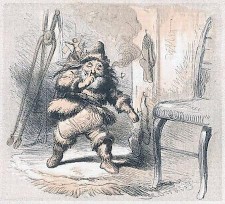Santa Claus
Nicholas of Myra: early Christian bishop, who was in the Middle Ages venerated as patron of sailors and protector of blessed marriages (Saint Nicholas). As Sinterklaas, he remains a characteristic figure in Dutch folklore. He is also the historical figure behind Santa Claus.

In 1626, Dutch merchants founded a town called New Amsterdam. The Lenape tribe received it for sixty guilders of gewgaw and were believed to have given up their title to the island of Manhattan, and a fortress was built. It was not the first Dutch settlement in the Americas, but it turned out to be a very important one, which was expressed in the grant of a privilege in 1653. Although its officials were Protestant, the city acknowledged the freedom of religion. There were Catholics who accepted Saint Nicholas as the patron of the city, and there were Protestants who liked to hide little presents in the shoes of their children. There are reports of official "visits" of Sinterklaas to the city. When New Amsterdam was captured by the English in 1664, the religious rights were mentioned in the Articles of Capitulation.
For the next century or so, both the Catholic saint and the more secular folklorist customs associated with him are almost absent from our sources, although a Catholic visitor of the city, now called New York, would know where to find the chapel of Saint Nicholas, and people still gave presents and told each other stories about Sinterklaas.
In this century, the date of the feast gradually wandered. Officially, it should be celebrated on the sixth of December, but we read about an actor visiting New York on New Year's Eve. There is no real explanation, but several factors may have contributed. One of them is that the old Germanic festival was not only combined with the Christian Saint Nicholas, but also to Saint Martin (11 November) and Epiphany (6 January). Gift exchange was simply something of the season and could be celebrated at any moment. Another factor may be the confusion of the calendars. Unlike the people on the European Continent, who had accepted the Gregorian calendar, the English continued to use the Julian calendar. It was easy for an event celebrated on 6 December to move to the nineteenth, and beyond. The details are obscure, because Sinterklaas was celebrated by the common people, whose daily life only seldom made it to the municipal archives.
In 1773, Saint Nicholas unexpectedly returned. The British demanded taxes from the American colonies but refused to give them a representative in Parliament. Following the incident known as the "Boston Tea Party", on 16 December, everywhere in the colonies, patriots started to organize societies to obstruct the British imperialists. In New York, they called themselves "Sons of Saint Nicholas", as an alternative to the pro-British societies of Saint George. In this way, Nicholas became a symbol of New York's non-English past, and he was therefore accepted as patron of the New York Historical Society.
The problem was that not much was known about the original celebration of Saint Nicholas in New Amsterdam. The lacuna was filled by the author Washington Irving (1783-1859), who in 1809 published a satirical book called Knickerbocker's History of New York from The Beginning of the World To the End of The Dutch Dynasty, in which Sinterklaas often played a role. In fact, Irving invented a tradition. His Nicholas resembled a corpulent Dutch citizen, smoking a Goudse pijp (a long white pipe made of clay, produced in Gouda). The venerable bishop had become "a chubby and plump, right jolly old elf", as he is called in the anonymous poem called A Visit From Saint Nicholas (1823). Within fifteen years, Father Christmas, including his fur-trimmed red dress, reindeers, sleigh, and cherry nose had been invented.
Among the cartoonists who contributed to the development of the iconography was the German-born illustrator Thomas Nast, who designed the covers and illustrations of the Christmas issues of Harper's Weekly Magazine between 1863 and 1886. He is responsible for the introduction of the name Santa Claus, a contamination of Sinterklaas and German Sankt Niklaus. Between 1931 and 1964, Coca Cola used Santa in its advertisements, which established him as an all-American commercial icon, not unlike Donald Duck and Mickey Mouse.
The development from the bishop of Myra to a marketing device is essentially a summary of western thinking about wealth.
- Saint Nicholas embodied the Catholic attitude that rich people must generously share their riches with the poor, because God had not created the difference in wealth;
- after the birth of Calvinism, which does not condemn profit as such, Dutch Protestants continued to celebrate the feast of Sinterklaas, although as secular folklore. As a censor of moral behavior, he appealed to their uneasiness about their immense wealth;
- finally, Santa Claus is an icon of Capitalism.